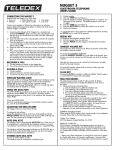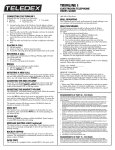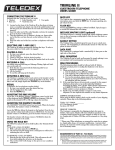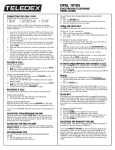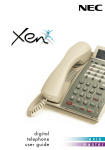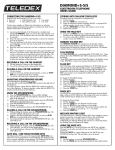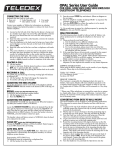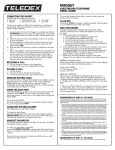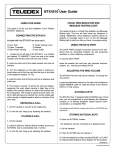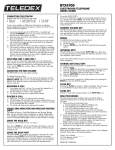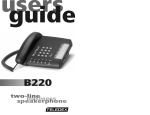Download Diamond+3- 5- 10 User Guide
Transcript
DIAMOND+3A/5A/10A GUESTROOM TELEPHONE USERS GUIDE CONNECTING THE DIAMOND TELEPHONE Included with the Diamond telephone are (one each): • Base unit • Coiled handset cord • User guide • Handset • Clear plastic overlay • Line cord Contact your supplier or Teledex for information on ordering custom designed and printed faceplates to enhance the look of your Teledex telephone. 1) Located on the left side of the telephone is a modular jack labeled TO HANDSET. Insert one end of the coiled handset cord into this jack. It is inserted properly when you hear a click. 2) Insert the other end of the coiled handset cord into the handset. 3) Turn the telephone so the back panel is facing you. Insert either end of the line cord into the jack on the back of the telephone labeled TO TEL. 4) Insert the other end of the line cord into a telephone wall jack. 5) Once your telephone is connected, place the paper faceplate over the keys. The plastic overlay slips into place by hooking the tabs on the overlay into the recessed slots located on both sides. The overlay is easiest to insert when the left or right side tabs are inserted first, and the middle part of the overlay is slightly bowed to allow for insertion of the other tabs. RECEIVING A CALL Lift the handset to answer incoming call. To end the call, hang up by replacing the handset. PLACING A CALL Lift the handset. Listen for dial tone, dial the desired number, or press an autodial key to automatically dial a number. To end the call, hang up by replacing the handset. MESSAGE WAITING LIGHT The raised red lens is a message waiting light. Many telephone systems turn on the red message waiting light to alert the user that there is a message waiting. Additionally, the message waiting light will act as a visual ring indicator, flashing when the telephone is ringing. USING THE DATA PORT The data port is a modular jack, located on the right side of the telephone, labeled DATA. You can connect a fax machine, computer modem, answering machine and other similar devices to the telephone line through this port. To use the data port, insert the line cord from the device you wish to connect into the jack labeled DATA. ADJUSTING THE RING VOLUME The telephone has two ring volume settings. To change the ring volume, locate the adjustment control on the back of the telephone labeled RINGER LOW/HI. Slide the switch to the desired volume. The ring volume can be changed at any time. AUTO DIAL / ONE TOUCH FEATURE KEYS Depending on your model, the telephone has up to ten (10) programmable auto dial keys. These keys can be programmed to automatically dial telephone numbers, or to activate telephone system features, when connected to a compatible PBX. STORING AUTO DIAL INFORMATION The telephone must be connected to a working telephone line. 1) Lift the handset. 2) Press the STORE key and release it (see diagram for key location). 3) Enter the telephone number (including PAUSE as required - see diagram.) The dialing sequence can be up to 15 digits long. 4) Press the auto dial key where the number is to be stored. 5) Replace the handset. HANDSET VOLUME KEY The HANDSET VOLUME key increases the handset volume to aid in hard to hear environments. At the start of each call, the handset volume is at a normal level. Pressing the HANDSET VOLUME key increases the handset volume. Pressing the key again increases the handset volume additionally. Pressing the key a third time returns the handset volume to the normal level. REDIAL To redial the last telephone number dialed, lift the handset, listen for dial tone, and press the REDIAL key. The telephone will dial the last number dialed. NOTE: Some PBX's require a pause after the first digit to access an outside line. The redial function will automatically incorporate a pause if the dialed number is 7 digits or more. The inserted pause will be of the same duration as set in the pause timing (see below.) CALL WAITING The CALL WAITING key is a programmable auto dial key. Upon shipment from the factory, the CALL WAITING key is programmed with a 600 ms hookflash. NOTE: Some PBX systems may require 'flash plus digits' to be dialed to access call waiting. Contact your system administrator for details. FLASH KEY The FLASH key, when programmed behind an auto dial key, provides a timed line interrupt typically used for accessing PBX/CO features such as transfer and conference. The timing of the hookflash is programmable, with the factory default timing set to 600 milliseconds. Some PBXs may require you to change the hookflash timing from the default 600ms. TO CHANGE HOOKFLASH TIMING: 1) 2) 3) 4) Lift the handset. Press the STORE key (see diagram.) Press the FLASH programming key (see diagram.) Select 1 - 9 on the dial pad. The number selected will be the new Flash timing in hundreds of milliseconds; ie: "3" = 300 ms. 5) Press the STORE key. PAUSE KEY The PAUSE key can be used to provide a timed pause between dialed digits within an auto dial key. The timing of the pause is programmable, with the factory default set to zero (0) seconds. To change pause timing: 1) Lift the handset. 2) Press the STORE key (see diagram.) 3) Press the PAUSE key (see diagram.) 4) Select 1 - 9 on the dial pad. The number selected will be the new Pause timing in seconds; ie: "3" = seconds. 5) Press the STORE key. WALL MOUNTING The telephone can be wall mounted. It is easiest to do the conversion when the handset and line cords are not connected. 1) Located on the front of the telephone, above the speaker grill, is the wall/desk mount clip. Remove this clip by pushing upward. 2) Rotate clip one half turn (180 degrees) so the side with the protruding edge is towards the top. This edge will hold the handset. 3) Slide the clip downward into the slot until it snaps into place. 4) Turn the telephone over onto a non-abrasive surface so the back side is up, facing you. 5) Locate the mounting bracket, and firmly push back and pull up to remove. NOTE: There are four (4) retaining tabs. 6) Rotate the mounting bracket one half turn (180 degrees) so that the mounting eyelet is facing in the same direction as the mounting eyelet located on the bottom surface of the telephone. 7) Insert the top two retaining tabs of the mounting brackets into the mounting bracket slots located near the middle of the telephone, then firmly push down and insert the retaining tabs on the opposite side. 8) Connect a short modular line cord into the jack on the back of the phone (labeled TO TEL). Route the line cord through the line cord channel. Connect the other end of line cord to the phone jack on the wall mounting plate. 9) Turn the telephone over, and slide the telephone onto the mount ing posts on the wall plate in a downward direction. Both eyelets should line up with the mounting posts. When properly installed, the telephone will be stable and secure. 10) Complete wall mounting by installing the handset and handset cord. This applies at any time during and after warranty. If unauthorized repair is performed, registration, connection to the telephone lines and remainder of warranty period all become null and void. 7) This equipment is hearing aid compatible. REQUIREMENTS OF PART 68 - FCC RULES NOTICE: The Industry Canada label identifies certified equipment. This certification means that the equipment meets certain telecommunications network protective operational and safety requirements as prescribed in the appropriate Terminal Equipment Technical Requirements documents. The department does not guarantee the equipment will operate to the users satisfaction. Before installing this equipment, users should ensure that it is permissible to be connected to the facilities of the local telecommunications company. The equipment must also be installed using an acceptable method of connection. The customer should be aware that compliance with the above conditions may not prevent degradation of service in some situations. Repairs to certified equipment should be coordinated by a representative designated by the supplier. Any repairs or alterations made by the user to this equipment, or equipment malfunctions, may give the telecommunications company cause to request the user to disconnect the equipment. Users should ensure for their own protection that the electrical ground connections of the power utility, telephone lines, and internal metallic water pipe systems, if present, are connected together. This precaustion may be particularly important in rural areas. Caution: Users should not attempt to make such connections themselves, but should contact the appropriate electric inspection authority or electrician, as appropriate. This device has been granted a registration number by the Federal Communications Commission, under Part 68 rules and regulations for direct connection to the telephone lines. In order to comply with these FCC rules, the following instructions must be carefully read and applicable portions followed completely: 1) Direct connection to the telephone lines may be made only through the standard modular cord furnished, to the utility installed jack. No connection may be made to party or coin phone lines. On the bottom of the phone is a label that contains, among other information, the FCC Registration Number and the Ringer Equivalence number (REN) for this equipment. If requested this information must be provided to the telephone company. The USOC Jack for this equipment is RJ11C. 2) The telephone company, under certain circumstances, may temporarily discontinue and make changes in facilities and services which may affect the operation of the users' equipment. However, the user shall be given adequate notice in writing to allow the user to maintain uninterrupted service. 3) In certain circumstances, it may be necessary for the telephone company to request information from you concerning the equipment which you have connected to your telephone line. Upon request of the telephone company, provide the FCC registration number and the ringer equivalence number of the equipment which is connected to your line; this information will be found on the device. 4) If any of your telephone equipment is not operating properly, you should immediately remove it from the telephone line. It may cause harm to the telephone network. 5) If the telephone company notes a problem, they may temporarily discontinue service. When practical, they will notify you in advance of disconnection. If advance notice is not feasible, the telephone company must; promptly notify you of such temporary discontinuance; afford the opportunity to correct the condition; inform you of your rights to bring a complaint to the FCC under their rules. 6) Repairs to the device may be made only by the manufacturer or an authorized service agency. REQUIREMENTS OF PART 15 - FCC RULES NOTE: This equipment has been tested and found to comply with the limits for a Class B digital device, pursuant to Part 15 of the FCC Rules. These limits are designed to provide reasonable protection against harmful interference in a residential installation. This equipment generates, uses, and can radiate radio frequency energy and, if not installed and used in accordance with the instruction, may cause harmful interference to radio communications. However, there is not a guarantee that interference will not occur in a particular installation. If this equipment does cause harmful interference to radio or television reception, which can be determined by turning the equipment off and on, the user is encouraged to try to correct the interference by one or more of the following measures: a) move the telephone away from the receiver. b) consult the dealer or an experienced radio/TV technician for help. Any changes made by the user not approved by the manufacturer can void the user's authorty to operate the telephone. INDUSTRY OF CANADA REQUIREMENTS The Ringer Equivalence Number (REN) of this device is Z. NOTICE: The Ringer Equivalence Number (REN) assigned to each terminal device provides an indication of the maximum number of terminals allowed to be connected to a telephone interface. The termination on an interface may consist of any combination of devices subject only to the requirement that the sum of the Ringer Equivalence Numbers of all the devices does not exceed 5. This telephone connects to the telephone network under the connecting arrangement code CA11A. TELEDEX DIAMOND+3A/5A/10A DIAGRAM DATA PORT RING VOLUME Adjusts the ringer volume to low or high setting. PAUSE KEY (hidden) For programming of PAUSE duration. See instructions for programming details. HANDSET HOLDER Used to temporarily hold the handset, without hanging up the telephone, when telephone is wall mounted. STORE KEY (hidden) Used in programming of number sequences. See instructions for programming details. HEARING AID COMPATIBLE HANDSET FLASH PROGRAMMING KEY (hidden) For programming of FLASH duration. See instructions for programming details. HANDSET RETAINING CLIP This removable clip can be rotated 180 degrees to allow handset to stay on hook when used in wall mount applications. MESSAGE WAITING LIGHT Signals that a message is waiting for retrieval. See your system administrator for instructions on retrieving messages. HANDSET JACK Modular jack for connecting handset to base. REDIAL KEY DIAL KEYS (DTMF PAD) Automatically redials last number dialed. For dialing phone numbers, and entering numbers to be stored in auto dial keys. CALL WAITING/FLASH KEY Sends a hookswitch flash, to enable call waiting or actuate other system features. AUTO DIAL KEYS For quick access to guest services. Depending on model, your telephone may have three, five, or ten auto dial keys. See instructions for programming details. FOR CUSTOMER SERVICE CALL: 1-800-783-8353 Part Number Coral 606-0482A00CL Rev. A 8/02 HANDSET VOLUME KEY Raises handset volume by repeatedly pressing. Continues to cycle through volume levels with each key-press. CONTACTING TELEDEX Teledex, LLC 6311 San Ignacio Avenue San Jose, CA 95119 Telephone: Fax: email: Internet: (408) 363-3100 (408) 363-3136 [email protected] www.teledex.com






